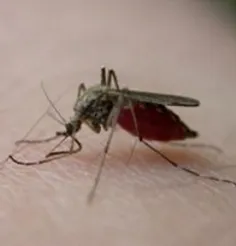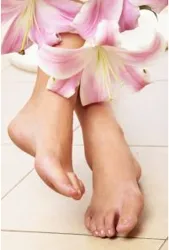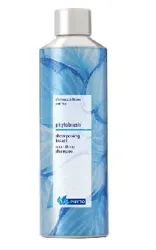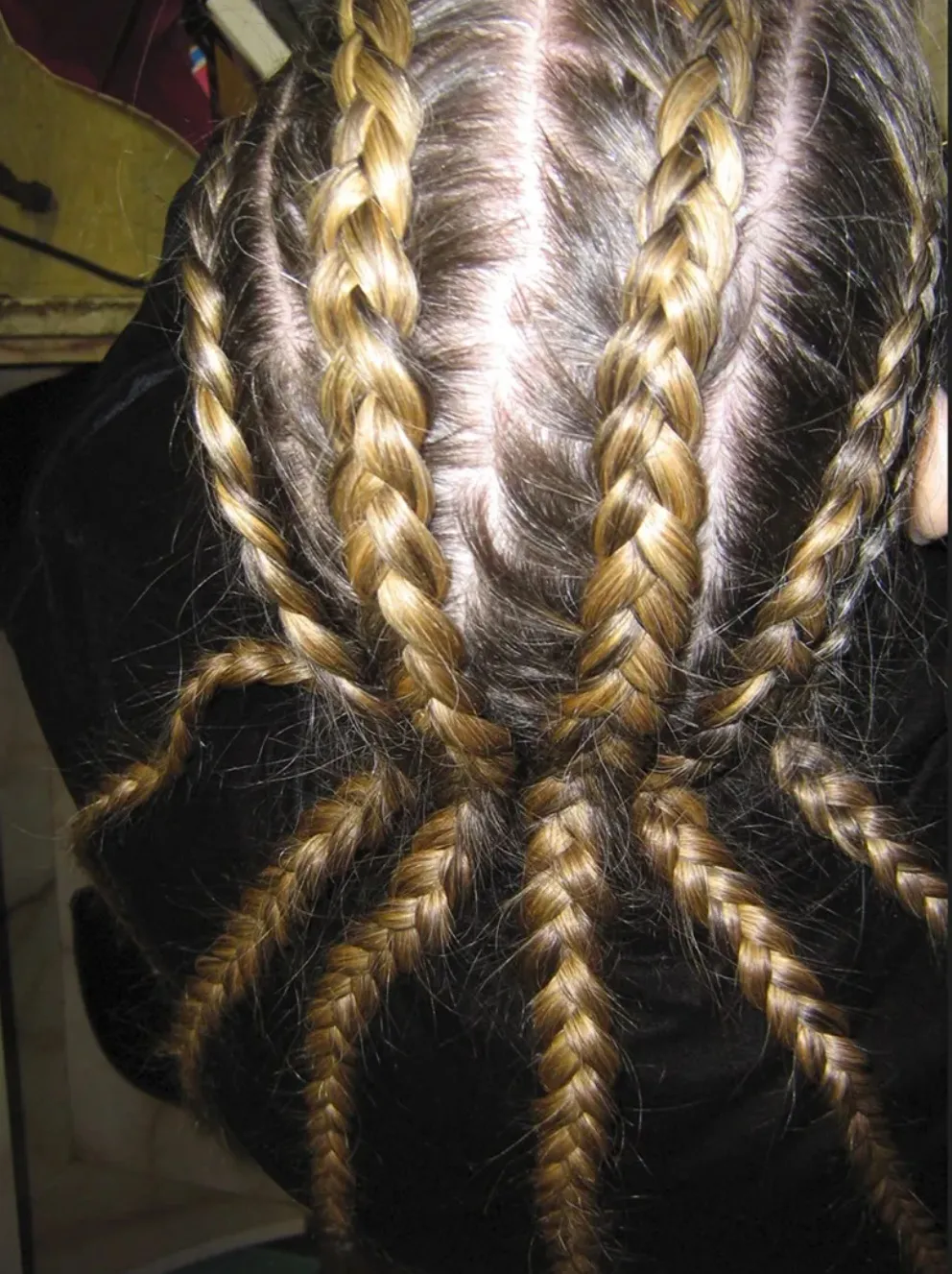
Tame Your Tootsies
Introduction
Wearing the proper footwear is always important but ongoing deep cleaning and maintenance should be included in your overall body care calendar. Whether you do it at home, or turn your toes over to the care of a professional, regular pedicures are a must-do.
Feet Problems That Can Develop
Although there are some foot conditions that develop due to lack of proper foot care and maintenance, most foot problems can usually be blamed on the shoes that are worn. Preventing foot issues can be as simple as wearing shoes that fit correctly and paying attention to good foot hygiene. The following foot conditions may be serious enough to require the attention of your friendly neighborhood foot doctor, known as either a chiropodist or podiatrist:
The following section of this article examines each of the foot conditions with regard to how they occur and how to prevent and treat them.
CornsA visible callus that forms on the feet is known as a corn and usually results from shoes that do not fit properly. Corns may have a tender spot in the center and are surrounded by red or yellow dead skin. These sores develop when the shoes press tightly against the foot causing a thickening of the epidermis. Hard corns usually develop on the top of the toe or on the side of the little toe. Soft corns which resemble open sores usually develop between toes that rub together. They may also develop at the back of the heel. Corns can also develop due to deformed toes such as hammer or claw toes. Other culprits in corn development include socks that don't fit correctly, Stilletto or high heeled shoes that increase the pressure on the front of the foot and a misplaced inside seam or stitch on the shoe that constantly rubs. Treating & Preventing CornsCorns, which are a relatively common foot problem, are treated by shaving the dead skin layers off with a scalpel. Although this procedure can be done at home, if the corn is large, extremely painful or if there are other complications, the corn should be shaved by a professional foot doctor. When treating the corn at home take the following steps:
Tools That Can Help With Corns
How to Use: Best used on moist skin. Gently draw Callus Shaver across callus in a shaving motion to remove thin layers of dead skin. Do Not Press Hard. Moist, dead skin should be removed easily. The blade is extremely sharp. Handle with care. Sterilize after each use. Severe corns should be treated by a podiatrist. Warning: In case of circulatory impairment or diabetes, contact your physician prior to use. Do not cut live skin or use on Diabetics or Hemophiliacs. Always available from Tweezerman to help with corns and foot calluses: Tweezerman - Three in One Pedicure Tool, Tweezerman - Callas Shaver & Dual Rasps and CornX Tool. Ingrown ToenailsAn ingrown toenail occurs when a portion of the toenail curves inward and grows into the flesh of the toe. The symptoms of an ingrown toenail include the area around the nail becoming hard, swollen and extremely tender. While this condition can occur on all the toes, it is most common on the big toe. This condition, which can be extremely painful may eventually progress from a sore nail into a serious infection that becomes red and pus filled. At some point, if the condition continues, callused or red granulation tissues, also known as "proud flesh" surrounding the ingrown toenail may start to grow up and over the ingrown toenail which makes the situation even worse. The danger of infection becomes more pronounced if dirt and sweat are allowed to enter the inflamed area.
This common condition can be prevented by using a top quality toenail clipper or scissors and cutting the toenails nails in such a manner as to minimize the possibility that the nails will grow down into the toe instead of straight up and away from the toe. The best approach is to cut nails straight across or slightly concave. Treating & Preventing Ingrown Toenails
Treat an ingrown toenail as quickly as possible to prevent it from becoming infected. Soak the nail in warm water to which a good antibiotic or germ busting soap has been added to create a sudsy liquid. It is recommended that you soak your foot at lest 3-4 times a day until the problem subsides. Always allow feet to dry completely and put on fresh clean socks. Wear open-toed shoes such as sandals or flip flops. To get relief from the pain you may need to gently lift the edge of the ingrown toenail from its embedded position with a sterilized ingrown toenail file. Once you have lifted the area, gently insert some sterile cotton or waxed dental floss between the nail and your skin to give the area some relief. Change this packing every day. Some ingrown toenails may reoccur. If you have a chronic problem with an ingrown toenail, your physician may suggest a surgical procedure in which the toenail’s formative part is permanently removed. PreventionIt is always better to take preventive measures to avoid the problems an ingrown toenail may cause. The best thing you can do to lower your risk of developing an ingrown toenail is to trim your toenails straight across with no rounded corners that can curve down into the toe. The length of your toenail should extend out and up past your skin. The top of each nail should form a straight line across, level with the top of your toe. Some additional guidelines for preventing ingrown toenails include:
Tools That Can Help With Corns
How to Use: Before bathing file top of nails with a regular nail file to reduce thickness. After bathing, while nails are soft, gently slide either end of File under ingrown nail. Choose flat or curved end depending on shape of nail and preference of use. Pull File out to thin the under surface of the nail and relieve pressure. Repeat several times. Care: Clean and sterilize after each use. Caution: If you have diabetes or poor circulation see a doctor for treatment of ingrown toenails. If swelling or discharge is present around nail, do not use this product and see a podiatrist. BunionBunions are a common problem, often caused by improper foot ware, that generally impacts women more often than men. They are basically prominent bumps that develop on the foot. Bunions can develop on the inside of the foot near the big toe joint or on the outside of the foot towards the joint of the little toe. The large toe bunion is referred to as Hallux Valgus. The bump is caused by a bone that protrudes towards the inside of the foot. As a bunion progresses it can cause the big toe to start to rest under the second toe which is known as overlapping toes. The bunion formed near the little toe is called a Tailor's Bunion, or a Bunionette. The type of bunion is a smaller bump that forms due to the movement of the little toe towards the big toes. Bunions may be caused by a variety of things ranging from improperly fitting shoes to arthritis and genetically malformed feet. Tight and excessively narrow shoes with a constrictive toe area may cause feet to assume the shape of the shoes, leading to bunion formations. Women are more prone to bunions because of a tendency to wear shoes that are too small. Tight shoes force the toes to be squeezed together causing the bones to protrude. Shoes that are tapered in the toe area, such as extremely pointed shoes may cause a bunion to worse to the point where surgery is required. As a bunion progresses the joint of the toe that it is impacted can become inflamed and enlarged causing pain and ultimately causing the foot to become deformed. Some of the symptoms of bunions include inflammation, swelling, and soreness on the side surface of the big toe. The discomfort commonly causes a person with bunions to walk improperly. Treating & Preventing BunionsIt is always best to prevent the development of bunions by wearing properly fitting shoes. If bunions are a risk because of family genetic patterns, arthritis or other conditions, discuss preventive measures with your physician. Soaking feet in warm water on a regular basis can provide temporary relief for first stage bunions. When bunions have already developed the best way to alleviate pain wear shoes with a high, wide toe area. Rocker soled shoes will relieve pressure from the bunion area. Look for shoes that provide extra comfort, support, and protection. Non-surgical treatments include the use of bunion shields, bunion night splints and bandages. These will slow or limit the growth of the bunion while providing pain relief. In some cases the only resolution for bunions are surgical solutions provided by a foot doctor or specialist. Flat FeetReferred to as Pes Planus as well as fallen arches, this condition can be genetic and thus inherited. The condition can also develop from constant standing or from extra pressure related to overweight, pregnancy or pounding on hard surfaces such in the case of some athletic events that weakens the natural arch of the foot, causing it to collapse or flatten. The arches of the feet are maintained by strong ligaments which are prevented from stretching by muscles in the legs. Strain and tiredness of these muscles may also result in fallen arches. For some people, flat feet are relatively painless. Others may experience discomfort ranging from mild to extreme. They also may develop other foot problems as a result of fallen arches. The condition can be successfully treated by exercise or by an artificial support of the arches in combination with the correct shoes. Treating & Preventing Flat FeetLike all the other foot conditions that have been previously examined, footwear plays a part. Properly fitting footwear with a firm heel counter that provides extra support and stability are ideal for preventing the problem from developing. Footwear that doesn't fit properly or provide adequate support may lead to additional problems. The condition can usually be treated with non-surgical options such as products designed to assist with arch support and realignment. If the problem persists or worsens a foot doctor should be consulted and other options can be accessed. Athletes footThis condition is caused by a fungal infection often contracted in warm, damp areas where the fungus can survive and thrive. Showers, health clubs, spas, dressing rooms and swimming pool lockers are primary breeding grounds. Since athletes spend considerable time in these environments, the disease was named for them. In the initial phase, athletes foot can manifest as red, dry, flaking skin with pain or itching. It can also show up as soggy white patches between the toes or along the soles or sides of the feet. Dry and cracking feet are often a sign of the presence of the infection. As the infection progresses into a more acute state, blisters that itch or weep can develop. The infection can spread to the toenails causing a chronic infection. If the infected foot areas are scratched and then the fingers immediately touch other parts of the body, the infection can quickly spread to the groin, underarm or other areas. Treating & Preventing Athletes foot
Some additional guidelines for preventing athletes foot include:
When a severe case of Athletes foot presents itself, medical attention is strongly recommended. While some fungal infections respond immediately to drugstore medicated powers, sprays or creams, others will stick around and become a chronic problem. A physician can diagnose the seriousness of the condition and then treat it with a combination of topical or oral drugs. Athlete’s Foot may be a special concern to people with diabetes and/or compromised immune systems who are more susceptible to developing infections that can lead to long term serious medical problems. Plantar wartsSimilar in some ways to Athletes foot, plantar warts are often contracted by walking barefoot on dirty surfaces or littered ground where the wart virus is lurking. The plantar wart virus, like the Athletes foot fungus, thrives in warm, moist environments. The wart viral infection is a common occurrence in communal bathing, spa or health club facilities. Plantar foot warts can grow to an inch or more in circumference and can eventually spread into clusters of several warts. When the warts grow and spread, they are often called mosaic warts. Just like Athletes foot, because these are infectious lesions, plantar warts can be easily spread by touching, scratching, or even by contact with skin shed from another wart. The wart may also bleed, another route for spreading. When plantar warts develop on the weight-bearing areas of the foot they can cause sharp, burning pain. Treating & Preventing Plantar WartsMost podiatric physicians do not recommend self treatment of plantar warts without their supervision. Although there are some wart-removal preparations available on the market, some doctors believe that without supervision you may do more harm than good. Surgical removal is often recommend with plantar warts. Lasers used in a Co2 cautery procedure have become a very common and effective treatment for dealing with wart lesions.
SummaryWhen it comes to foot problems, shoes and lack of proper maintenance and care are often the culprits. Everything from corns and bunions to fungus infections can be directly linked to shoes that do not fit properly or to toes that are not carefully groomed and maintained. The bottom line? Take the time to prevent problems before they occur and you will walk on happy, healthy feet. |
| If you want to talk more about this or other hair care articles on HairBoutique.com or anywhere else, please post a message on HairBoutique.com's Hair Talk Forums.
|
Social Media Network Information
Please follow us on Twitter at: https://Twitter.com/HairBoutique. I look forward to meeting new people from all walks of Twitter and learning from their Tweets.
























